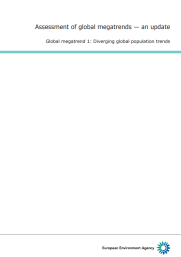
Global megatrend update: Diverging global population trends

Authors’ abstract
Across the world, the basic determinants of population size and structure — fertility, mortality and migration — have been fundamentally altered by the processes of social and economic development. As a result, the global population doubled to 7 billion in the last half century and will continue growing fast in coming decades, although regional trends differ markedly. In advanced economies, populations are ageing and in some cases reducing in size. At the other extreme, populations in the least developed countries (1) are expanding rapidly. Migration is also affecting the distribution and structure of populations, as people move in search of higher earnings or to escape conflict or environmental degradation.
An expanding workforce relative can create a ‘demographic dividend’ of greatly increased economic output. But it can also create the risk of social unrest if there are insufficient employment opportunities. Furthermore, some of the returns from the demographic dividend must be invested in areas such as health and education, and in savings for retirement, if living standards are to be sustained as the population ages.
If the world remains on its current development path, population growth and investments in human capital will continue to provide a boost to global economic output, potentially increasing the burdens on natural capital stocks. But the challenges facing regions will vary. Developing countries will need to identify ways to exploit the opportunities presented by a large economically active population and few dependents. Advanced economies will need to maintain living standards as the elderly population expands and the workforces contracts.
- Issue:
- Demography, Urbanization and Migration
- Region:
- Global
- Year Published:
- 2014
- Authors:
- Anita Pirc Velkavrh, Michael Asquith
- Institution:
- European Environment Agency (EEA)

